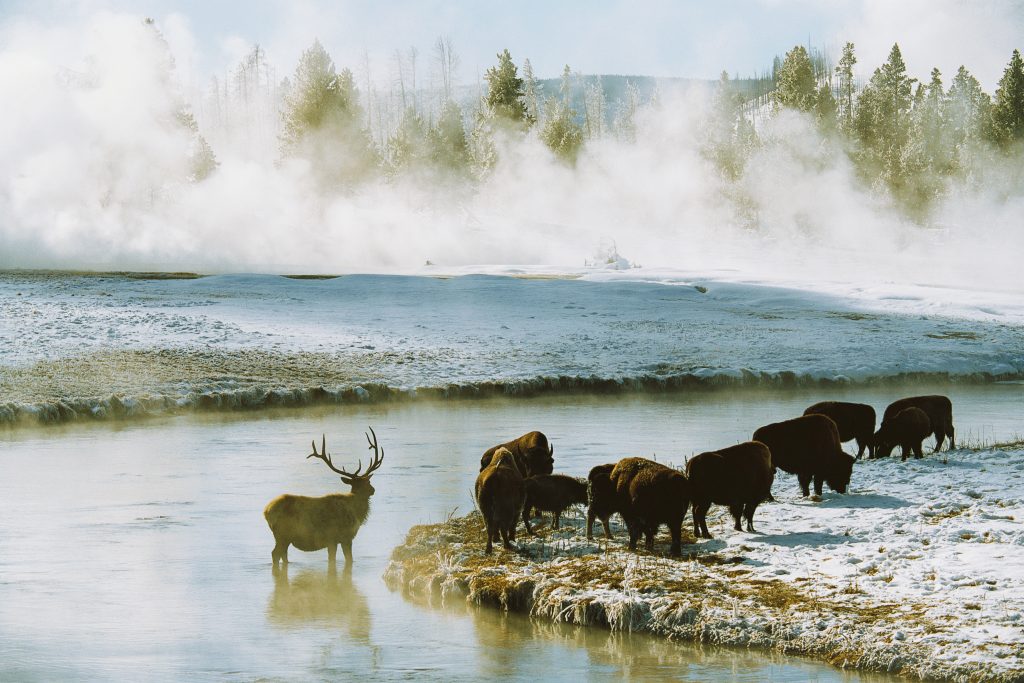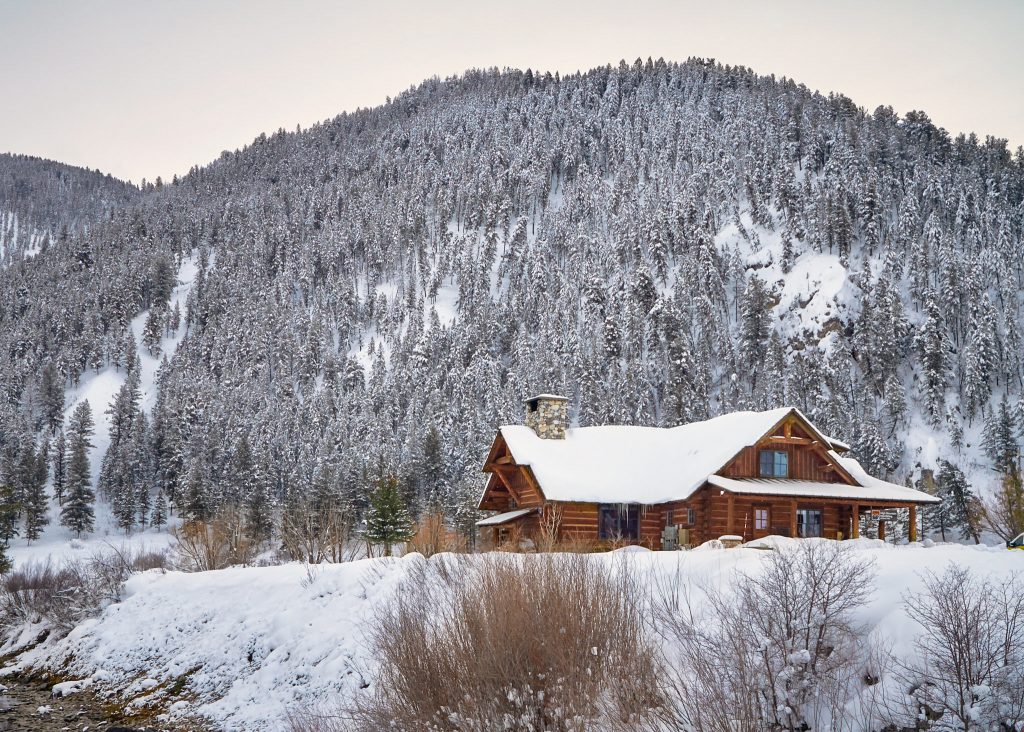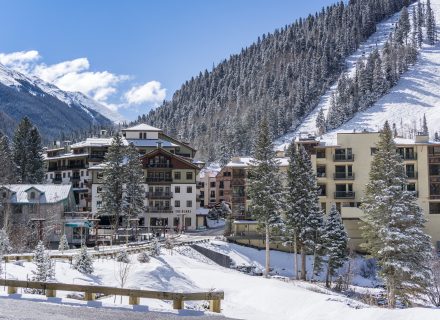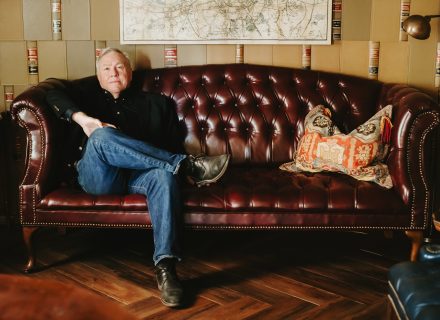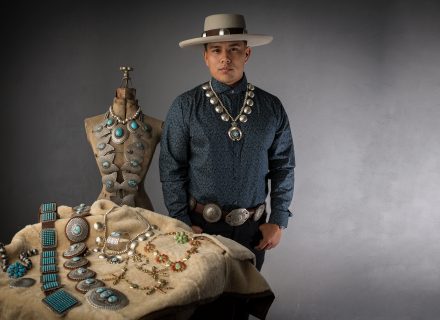With every winter-wonderland attraction during the day and a crackling fire and Wyoming whiskey at the Snake River Sporting Club in the evening, we chill out in Jackson Hole.
I know there is a resort here — I drove past a small building manned by a friendly guard and under an arched entrance welcoming me to the Snake River Sporting Club—but as my car climbs up a butte above the Snake River in Jackson Hole, signs of civilization fall away. In less time than it takes me to think, This is really remote, and it’s wonderful, the only mark of man I see is the plowed road, which winds through snowbanks that are easily twice as tall as my SUV.
I’m headed for a two-bedroom cabin where the fireplaces are turned on by a switch, down comforters cover beds, and the kitchen is stocked. Still, the empty expansiveness of the landscape causes me to feel more like one of this valley’s earliest settlers than a guest at a very 21st-century mountain retreat that includes concierges, a clubhouse, an ice skating rink, an equestrian center, a tubing hill, a Nordic center, more than 50 private residences, and a few tricked-out “tiny houses” for nonmembers, among other things.
In winters that aren’t as snowy—I’m here during the month in which Jackson Hole records its second-highest ever valley snowfall, 51.8 inches in 27 days—it’s possible that you’ll see the Sporting Cabin before turning into its driveway. But last February, it appeared out of nowhere. As much snow as there is though, the driveway and walkway to the front entrance are shoveled with die-cut precision.
My plan for this time in Jackson Hole is to experience as much of the area as possible. I arrive at the Snake River Sporting Club with no firm commitments but several possibilities on my radar: skiing at Jackson Hole Mountain Resort, one of the best resorts in North America, and maybe also even at the small-but-steep Snow King Mountain; a sleigh ride on the National Elk Refuge; snowshoeing in Grand Teton National Park; a snowmobiling tour; exploring downtown Jackson, where the Town Square’s elk antler arches are as photogenic as ever and restaurants, art galleries, cafes, and boutiques are increasingly diverse and well-curated; the National Museum of Wildlife Art, which has a permanent collection of more than 5,000 works of art and artifacts and takes a wonderfully wide view of the genre; and Nordic skiing right here at the Snake River Sporting Club, where 10 miles of groomed trails start from the clubhouse. Heli-skiing is also an option. One of Jackson Hole’s only helipads is at the Sporting Club’s entrance.
But all of these ideas are forgotten as soon as I walk into my home for the next couple of nights. The gas fire in the living area is going, there’s a bottle of Wyoming Whiskey on the bar, and the sofa and chairs in front of the fire look soft and overstuffed and face a wall of windows that frame a life-size snow globe. I can ski, snowmobile, snowshoe, eat, and shop in many places. I’ve never stayed in a cozy cabin in the middle of nowhere before.
That night, instead of driving the 25 minutes to Jackson like I thought I would to enjoy the steak tartare pizza, crispy pork shank, and toffee pudding at the Snake River Grill, I eat a couple of the KIND bars I always travel with in case of emergencies and sip Wyoming Whiskey in front of the fire. I alternate between reading and watching giant snowflakes fall outside. There’s a TV here, but no part of me is tempted to turn it on.
Jackson Hole’s first visitors and residents were Native Americans. Tribes including the Shoshoni, Blackfeet, Bannock, Crow, and Gros Ventre hunted and temporarily lived in the valley for centuries before the first homesteaders arrived in the 1880s. Names are all that remain of their time here, though. The town of Jackson was incorporated in 1914 and growth was slow but steady. (Jackson Hole is the name for the entire 42-mile-long, 8- to 15-mile-wide valley. Jackson is the biggest town in the valley; other communities include Kelly, Moose, Moran, Wilson, Teton Village, and Hoback Junction.) Jackson’s last dirt street was paved in the 1970s, and it wasn’t until the mid- 1990s that the town’s population exceeded its elevation (6,237 feet above sea level).
Twentieth-century visitors and residents were often athletes, hunters, artists, dudes, and conservationists. In the 1910s and ’20s it was Jackson Hole dude rancher and writer Maxwell Struthers Burt who helped popularize the idea of a dude ranch vacation. (Burt was one of the co-founders of the Bar BC. His memoir, Diary of a Dude Wrangler, was republished by Sastrugi Press Classics in 2019.) Starting in the 1940s, Archie “Teton” Teater sold his paintings of the Tetons and Jackson Hole from various locations around the valley. Olaus and Mardy Murie, a couple who were instrumental in drafting what became the landmark Wilderness Act of 1964, which established the legal definition of wilderness and protected almost 10 million acres of federal land as such, lived in Jackson Hole. From its founding in 1965, the Jackson Hole Mountain Resort drew extreme skiers with its unparalleled expert terrain.
This century, the valley has increasingly found itself on the radar of the international jet set. Jackson Hole is home to the first ski-in/ski-out Four Seasons in the world, the first Aman Resort in North America, and the Kansas City Federal Reserve Bank’s annual Economic Policy Symposium (every August at Jackson Lake Lodge). Also, there are spectacular and unparalleled wildlife watching opportunities here. The Greater Yellowstone Ecosystem, the 15-millionish-acre area that includes Yellowstone and Grand Teton national parks and adjacent national forests, is one of the most nearly intact temperate-zone ecosystems in the world. Black and grizzly bears, wolves, moose, bison, and elk all live here. In 2018, Grammy Award-winning rapper Kanye West held the listening party for his album Ye at a dude ranch near Moose. Magazines like Rolling Stone and Vogue and the 300-plus musicians and celebrities at the party splashed Jackson Hole’s wildlife and wild lands across their websites and Instagram feeds.
Jackson Hole has spent more than 20 years transforming itself into a ski resort the whole family can enjoy (rather than a resort that brings all but the best of skiers to tears). It has upgraded its ski school and lifts, added new lifts, and increased beginner and intermediate terrain and on-mountain amenities. These efforts have paid off. In 2013, readers of SKI magazine named it the overall best ski resort in North America, a ranking that has been repeated several years since and by other magazines, including Forbes.
So, while I can ski, snowmobile, snowshoe, eat, and shop in many places, I can’t do them all in one place at the level offered in Jackson Hole. I’m glad my first night at the Snake River Sporting Club was relaxing, but the next morning I get up determined to experience Jackson Hole. The options are overwhelming.
Because making serious decisions on an empty stomach is worse than snowmobiling in a whiteout, I drive into Jackson for breakfast. Do I want Sweet Cheeks Meats’ breakfast sandwich of the day, which their Instagram feed tells me is the Sunnyside Swine (maple bacon sausage with egg and cheese on a house-made buttermilk biscuit), or a chocolate croissant and Intelligentsia espresso at Persephone Bakery? Because the latter is served in a historic cozy cabin one block from the Town Square, I head for Persephone and promise myself I’ll hit Sweet Cheeks another day.
Sitting at a marble-topped table beneath a wall decorated with dozens of antique wooden spoons arranged in geometric patterns, I narrow down my choices for the day to downhill skiing, a ranger naturalist-led snowshoe tour in Grand Teton National Park, and a sleigh ride into the 8,000-plus-strong Jackson Hole Elk Herd. And then I get no further. I want to do all three things equally. Because I know there’s a fireplace, comfortable couch, and Wyoming Whiskey waiting for me back at my Sporting Club cabin, I come up with an ambitious itinerary that includes all three. The snowshoe tour isn’t offered until 1:30 p.m., so I’ll start with the hour-long Elk Refuge sleigh ride. Then it’s a 20-minute drive to Grand Teton National Park’s Bradley/ Taggart lakes trailhead, from where the guided tour departs. And finally, Snow King Mountain has night skiing. It’s the ultimate Jackson Hole day. I cross my fingers that I won’t require the following day to recover from it. Tomorrow I want to Nordic ski at the sporting club and hit the JHMR in the afternoon.
Having done a sleigh ride onto the National Elk Refuge several times before, I know generally what to expect: After I’ve wrapped myself in a Pendleton wool blanket (smartly provided by the sleigh ride outfitter), Percheron horses will pull us close enough to groups of elk that I can almost count their eyelashes. If we’re lucky, we’ll also see a bald eagle and coyotes. If we’re really lucky, we’ll see a wolf in the distance. The tour ends with our sleigh being lucky, but not really lucky: We see elk, one bald eagle, and three coyotes. A new sight this time is two bull elk mock fighting within 20 feet of my side of the open sleigh.
I have no expectation for the GTNP snowshoe tour, but I do have apprehension. Snowshoeing is not my favorite activity, mostly because the part of it I’m good at is tripping. But I really want to learn about the park’s winter landscape. Arriving at the trailhead, past which the road is buried beneath several feet of snow, about a dozen people are congregated around a wooden shed at the northwest corner of the parking lot. An added benefit (beyond the ranger naturalist) to this snowshoe tour is that it comes with snowshoes unlike any I’ve used before. GTNP has the National Park Service’s only collection of historic snowshoes. Each pair of ash-and-rawhide snowshoes in the shed dates from the 1940s or ’50s.
After several minutes of getting used to the oversized snowshoes — they’re about three times as long as typical modern ones — our group follows ranger naturalist Katie Tozier toward the Tetons. While the mountains rise 7,000 vertical feet just in front of us, Tozier keeps us on the flats for the entire 90 minutes and has us stop often. From an overstuffed backpack she exhumes pelts of some of the park’s most winter- adapted wildlife, such as wolverines and red fox, and passes them around for us to examine. We learn that the former, which haven’t actually been sighted in the park in several years but are known to be very human-averse, can smell a frozen carcass beneath 20 feet of snow and chew through bone. At another stop she explains how the back legs of moose have “knee” joints that bend in the opposite direction of ours. This lets them easily pull their legs up and out of snow as they walk. Later she asks us to stick our heads into a lodgepole pine, inhale deeply, and describe the smell. Our group isn’t too imaginative.
We come up with “Christmas,” “citrus,” and “Pine-Sol” before Tozier tells us about terpenes, the chemical compounds that give conifers their scent. We don’t cover more than a mile and a half, and because Tozier, like a good ranger naturalist, has us going slowly and stopping to notice details I otherwise would not, it’s the best time I’ve ever had on snowshoes — and I don’t fall at all.
Driving back into town I realize that for all the activities I planned, I did not plan lunch. Palate opened at the National Museum of Wildlife Art in 2017 and serves lunch daily when the museum is open. I have a bison gyro at a table overlooking the National Elk Refuge, then tour the museum’s 14 galleries. The same summer Palate opened, to celebrate the museum’s 30th anniversary, Adam Duncan Harris, the museum’s Joffa Kerr chief curator of art, and the curatorial team recently rehung and reinterpreted five galleries: Pathways Gallery, JKM Gallery, Gilcrease Gallery, Rungius Gallery, and Widener Gallery. “You could experience these as individual units or as consecutive chapters,” Harris tells me later. Each gallery has its own focus, and, he says, “The overriding theme is based on the idea of exploring. People come to Jackson Hole to explore the outdoors and nature and wildlife; we want to tap into that.”
From the museum, I’m ready to tap into some outdoor adventure. Five blocks from the Town Square, Snow King is definitely not a destination ski resort like JHMR. (It doesn’t rank in SKI magazine’s readers poll in any category.) But it was the first ski area in the state of Wyoming and remains relevant today because it’s inexpensive, there are no lift lines, and it offers the only night skiing in Jackson Hole. Also, the Jackson Hole Ski & Snowboard Club trains here. Local Olympic ski racers Resi Stiegler and Breezy Johnson grew up training and racing on the King. In two hours, I ski all of the open runs a couple of times. Eighty percent of the time I am the only skier on a run.
The busy-ness of the day hits me as I pull off my ski boots. Another Kind bar dinner is tempting. Even if I could get a reservation at the Snake River Grill or another favorite like Trio Bistro or The Kitchen, I don’t know that I have the energy. Also, I want a glass of wine, and at this elevation even a single glass would make the 19-mile drive from downtown Jackson back to the Snake River Sporting Club unwise (and possibly illegal).
Thinking of wine gets me thinking about Bin22, a wine shop that also sells a small selection of house-made salumi, specialty cheese, sauces, and cook-at-home pastas. My Sporting Cabin has a full kitchen. Driving back through downtown Jackson, I stop at Bin22 and get a bottle of Argentinian Malbec.
Back at the cabin, I eat two ice cream sandwiches while cooking gnocchi and when I fall into bed, I sleep the sleep of the dead, or of someone who overdid it that day.
I take it easier the rest of my time at the Snake River Sporting Club. I spend a morning exploring its groomed Nordic trails, almost skate into a moose, and then have a burger for lunch at the clubhouse. One afternoon I head for the Jackson Hole Mountain Resort. With all the fresh snow, there isn’t a bad run to be had, but the off-piste trees between the Thunder and Sublette lifts are particularly great. The après-ski massage I get at the Four Seasons is even better, though.
When my time at the Sporting Club is over, I’m pleased at how many of the things on my list I did. Next time snowmobiling and heli-skiing will be at the top of the agenda along with something new: soaking in natural hot springs. In summer 2020, after years of fundraising, design, and construction, the historic Astoria Hot Springs will reopen right next to the Sporting Club’s entrance. I have a feeling that once Astoria reopens, soaking in its natural hot springs will be the best way to end any day in Jackson Hole.
More on Snake River
Snake River Sporting Club
Winter Gear
Photography: Courtesy of Visit Jackson Hole and Snake River Sporting Club
From our January 2020 issue.







